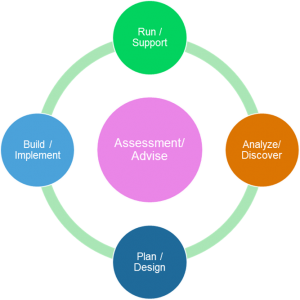Digital Transformation: An Interview with Rania Mohamed (Global Services)
We’ve heard the mantra loud and clear. Business must transform to become digital businesses to survive. And the numbers are stark, with 80 % of businesses striving to make the transition by 2021.
We sat down with SUSE Solutions Architect, Rania Mohamed, to get her perspective on what ditgital transformation is and how you can start your own transformation.
Rania, what is digital transformation?
Digital transformation is the mechanism of transforming the business into digital business — in other words, digitalizing the business.
Digitalizing the business means integrating different business context to enable a smart digital market. That is, each business entity learns from other business entities. This, in turn, contributes to the learning curve in the digitalization lifecycle. Ultimately, each entity builds a big ecosystem that enables:
- Enhancement to the end user experience
- Continuous innovation through completive advantage
- Responsive business actions rather than reactive ones.
Data is the main entity of the ecosystem; it is the master of digitalization. That’s why the main architecture principle in the digital transformation is to build a digital business model. A digital business model can look like this:

Rainia, how do I go about doing that?
First, we have to understand that the backbone of the digital business is the ability to produce data in a fast, easy and standard way. We also need to digest data in the same speed and take faster responsive actions.
The main architecture principles of a digital business include:
- Agility to deliver the requested speed and act in a proactive manner
- Ease of scalability, it must scale very fast and efficiently
- High resiliency, ability to self heal in a fast manner with zero human interaction
- Highly reactive and responsive architecture
- Elimination of all performance bottlenecks
- Integrable and secure
Yes, Rania, but how is the data involved in the former principles?
Simply put, data fuels digitalization. The lifecycle starts with data and ends with data. In another word, digitalization does not happen without data.
So, Rania, if data is the fuel of digital transformation, what is the engine that is digesting it?
The simple answer is event processing, or actually in our case, complex event processing (CEP).
CEP is the process of performing actions based on an event or a series of events happening in a specific order. Let’s take the example of alerting g a system/vendor that there is an increase in the shopping of a specific item. The event(s) in this case is the specific item shopping rate increase and the action taken is alerting the vendor.
In the digitalize business, data is important not only on the storage level but also on the event triggering and processing level. Data is used to learn about the digital market and enrich/enhance the business.
Ok, but why risk what is already stable and running?
The market is pushing and enforcing enterprises to do digital transformation, or else they are going to lose the business and shrink rather than grow in the market.
Just look at these two quotes from industry leaders:
“In today’s era of volatility, there is no other way but to re-invent. The only sustainable advantage you can have over others is agility, that’s it. Because nothing else is sustainable, everything else you create, somebody else will replicate.”
Jeff Bezos, Amazon
“At least 40% of all businesses will die in the next 10 years… if they don’t figure out how to change their entire company to accommodate new technologies”
John Chambers, Cisco
In other words, if you don’t transform your business,you are destined to be part of the 80% of companies that are at risk of collapse according to Techcrunch. And in their recent survey, 54 percent of CIOs said they expect their company to be gone by 2021 if they don’t digitally transform.
Final question Rania, how can enterprises be comfortable as they start their digital transformation journey?
This will only happen if digital transformation is done using a proven well defined process and a set of proven enablers. This will minimize the risk if not eliminate it and will encourage an enterprise to move towards transformation.
Here are some ideas on the process for handling digital transformation:
- First, list the drivers and goals of the digital transformation to meet the digital business architecture principles:
| Drivers | Goals |
| Cost Reduction | Modernize underling services (infrastructure, platform and software) including enhancing the user experience |
| Increase Agility | Increase solution and business governance |
| Enable DevOps | Consolidated and integrated solution |
| Transform Business | Business process automation |
| Digitalize Enterprise | Accelerate time to market |
| Minimize the Risk | Ease of integrating new business/services |
-
- Define the digital transformation scope and phase the transformation as waves (small groups of applications/features migrating together). The transformation scope includes:
-
- Discovering the enterprise IT strategy
- Gathering the transformation requirements
- Understanding the current mode of operation
- Determining the target landing zone, it could be ground, public cloud, private cloud or hybrid.
- Designing and defining the solution of the transformation or the migration method.
- Integrating the target solution with the enterprise ecosystem and the Digital Ecosystem.
- Run the process phases which include (assessment, discovery, designing, implementation and support), repeating a phase as much as you need to in an agile manner.
- Start small, prove your premise, and grow your project.
And remember, this is an iterative process that we can repeat as illustrated below:

I’d like to thank Rania for her knowledge in how to start digitizing the business. Rania is part of the SUSE Global Services team. Learn more about how SUSE can help you start your journey!
Related Articles
Jul 04th, 2022
No comments yet